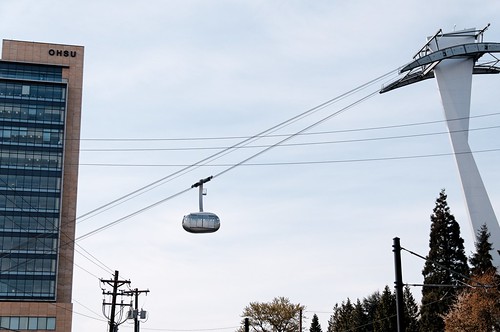This past summer I brought attention to the Rheinseilbahn in Koblenz, Germany. In a past post I suggested it was likely a strong example of an Urban Gondola given its innovative design. That opinion, however, was based upon second and third hand knowledge, not first-hand experience. Last month, however, I had the opportunity to visit Koblenz and tour the Rheinseilbahn myself.
This is Part 4 of a 5 part photo essay resulting from that journey. Click here to read Part 1. Click here to read Part 2. Click here to read Part 3. Click here to read Part 5.
Unless otherwise noted, all images by Steven Dale.
If there is one major design flaw in the Koblenz Rheinseilbahn, it is within the tower infrastructure.
While system designers and architects did a wondrous job on the vehicles and stations it seems as though the tower elements were almost forgotten about. It’s a shame because had the designers found an innovative and beautiful way to make the towers sculptural rather than simply utilitarian you could argue that the Rheinseilbahn is one of the most elegantly designed cable systems ever.
Like station design, I’ve heard numerous complaints from planners, policy-makers and decision-makers about cable towers in general. Those elements, the argument goes, are simply not compatible with current practices in urban design. That’s a very hard argument to disagree with when tower elements look more like oil derricks and electricity towers.
Part of the problem here lies in technology choice: The 3S system employed here simply needs more support than other technologies. Funitels, MDGs and BDGs can all be built using lower profile towers that can more easily be blended into the urban fabric.
Don’t take that to mean a 3S systems cannot use more sculptural tower designs. They can, it’s just not something that’s common practice in the industry.
Cable engineers have assured me that 3S tower designs can be reconfigured in a variety of ways.
One of the pieces of evidence for this is the Portland Aerial Tram. There, city officials had grave concern about the appearance of the towers and requested a customized design. Granted, this (among other things) added significant cost to the project, but it demonstrates that it’s possible.

The Portland Aerial Tram is one of the few cable systems in the world with customized, sculptured tower infrastructure. Such design adds to the urban fabric rather than detracting from it. Image by Thomas Le Ngo.
Astute readers will quickly point out that the Portland system is an Aerial Tram not a 3S. This is true. But as I’ve stated before, the 3S is nothing more than a hybrid between standard Detachable Gondolas and Aerial Trams.
If engineers can accomplish the Portland Aerial Tram towers, they can certainly accomplish something similar with 3S systems.
Such a design flourish would’ve taken the Rheinseilbahn to a whole other level. Given the lightness of the station architecture and the green park setting of the towers, something more in keeping with the surrounding context would’ve been more appropriate.
Instead, the towers stick out like cell phone towers in a forest.
In fairness to the designers, this is not entirely their fault. The Rheinseilbahn was originally meant only as a temporary system for the BUGA horticultural exhibition. Spending the resources on beautiful towers for something so fleeting would’ve been fiscally irresponsible.
However, now that it appears the Rheinseilbahn will remain a permanent fixture in Koblenz, it’s truly unfortunate more thought wasn’t paid to these elements. But of course, hindsight is 20/20.
With only two towers in the entire system, the towers don’t undermine the Rheinseilbahn’s many successes. From a design perspective, it is still one of the most elegant and stunning Urban Gondolas ever built. But like most beauties, there’s always a blemish or two.
Hopefully, as the industry penetrates deeper into the urban market, questions of urban design and urban fabric will become more and more important.
Every system need not have their own customized towers. Tower customization as in the case of Portland would drive up the cost of the technology unnecessarily. But developing standardized 3S tower designs that are more in keeping with the urban environment would certainly be a step in the right direction.





2 Comments